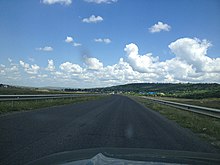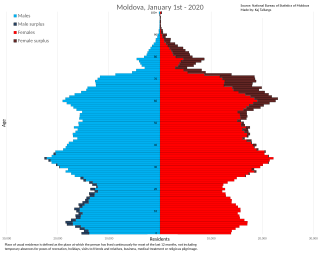
Demographic features of the population of Republic of Moldova include distribution, ethnicity, languages, religious affiliation and other statistical data.
In 1995, the main means of transportation in Moldova were railways and a highway system. The major railway junctions are Chișinău, Bender, Ungheni, Ocnița, Bălți, and Basarabeasca. Primary external rail links connect the republic's network with Odesa on the Black Sea and with the Romanian cities of Iași and Galați; they also lead northward into Ukraine. Highways link Moldova's main cities and provide the chief means of transportation within the country, but roads are in poor repair. The country's major airport is in Chișinău.

Transnistria or Pridnestrovie, officially known as the Pridnestrovian Moldavian Republic (PMR), is an internationally unrecognized state, recognized as part of Moldova. Transnistria controls most of the narrow strip of land between the Dniester river and the Moldova–Ukraine border, as well as some land on the other side of the river's bank. Its capital and largest city is Tiraspol. Transnistria has been recognised only by two other unrecognised or partially recognised breakaway states: Abkhazia and South Ossetia. Transnistria is officially designated by the Republic of Moldova as the Administrative-Territorial Units of the Left Bank of the Dniester or as Stînga Nistrului. In March 2022, the Parliamentary Assembly of the Council of Europe adopted a resolution that defines the territory as under military occupation by Russia.
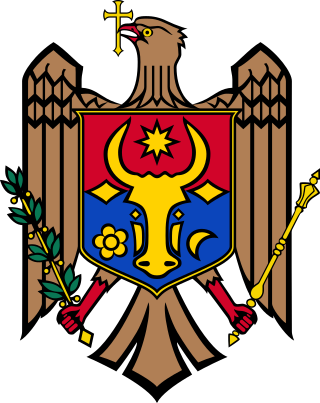
According to the Moldovan law on territorial administrative organisation, Moldova is divided administratively into the following administrative territorial units: districts, cities/towns and villages. The administrative territorial organization of Moldova is made on 2 levels:
- villages (communes), sectors and cities/towns (municipii) constitute the first level,
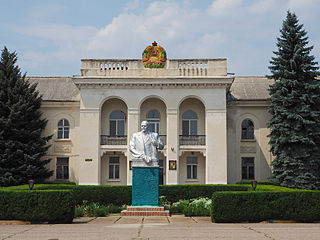
Dubăsari or Dubossary is a city in Transnistria, with a population of 23,650. Claimed by both the Republic of Moldova and the Transnistrian Moldavian Republic, the city is under the latter's administration, and functions as the seat of the Dubăsari District.

The Transnistria War was an armed conflict that broke out on 2 November 1990 in Dubăsari between pro-Transnistria forces, including the Transnistrian Republican Guard, militia and neo-Cossack units, which were supported by elements of the Russian 14th Army, and pro-Moldovan forces, including Moldovan troops and police.

This is the history of Transnistria, officially the Pridnestrovian Moldavian Republic (PMR), an unrecognised breakaway state that is internationally recognised as part of Moldova. Transnistria controls most of the narrow strip of land between the Dniester river and the Moldovan–Ukrainian border, as well as some land on the other side of the river's bank.
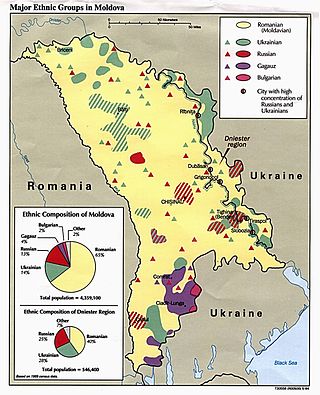
The Romanian-language schools in Transnistria are subject to limitations by the government of Transnistria, an unrecognized breakaway region of Moldova since 1992.

European route E 58 is a road part of the International E-road network. It begins in Vienna, Austria and ends in Rostov-on-Don, Russia. It is approximately 2,200 km (1,400 mi) long.

Currently, the Russian Federation holds an unknown number of soldiers in Transnistria, an unrecognized breakaway state internationally recognized as part of Moldova. This Russian military presence dates back to 1992, when the 14th Guards Army intervened in the Transnistria War in support of the Transnistrian separatist forces. Following the end of the war, which ended in a Russian-backed Transnistrian victory and in the de facto independence of the region, the Russian forces stayed in a purportedly peacekeeping mission and reorganized in 1995 into the Operational Group of Russian Forces (OGRF), currently guarding the Cobasna ammunition depot. Some other Russian soldiers also participate in the Joint Control Commission between Moldova, Russia and Transnistria since 1992.

Pridnestrovian Moldavian Republic (Transnistria) official statistics show that 91 percent of the Transnistrian population adhere to Eastern Orthodox Christianity, with 4 percent adhering to the Catholic Church. Roman Catholics are mainly located in Northern Transnistria, where a notable Polish minority is living.

This timeline of events is a chronological list of incidents and other notable occurrences related to the War of Transnistria, including events leading up to the war.

Calea Ferată din Moldova is the sole railway operator in the Republic of Moldova, responsible for passenger and cargo transportation, as well as railway infrastructure maintenance within the country. The total length of the network managed by CFM is 1,232 kilometres (766 mi), of which 1,218 kilometres (757 mi) are 1,520 mm, and 14 kilometres (8.7 mi) are 1,435 mm. The entire network is single track and is not electrified. It borders the Romanian railway network, with a 1,520 mm /1,435 mm break-of-gauge in the west, and the Ukrainian one in the east.
The M1 highway is a road in Moldova connecting the border with Ukraine near Dubău to the border with Romania at Leușeni, passing through Chișinău and Dubăsari. It is 154 km (96 mi) long and forms part of the European routes E58, E581 and E584.
The M3 highway is a partially built road in Moldova, which links Chișinău to the southern part of the country via Gagauzia. The road forms part of the European routes E87 and E584 and will have a total length of 217 km (135 mi) when completed. The road passes through Cimișlia and Comrat before reaching its southern terminus, at the border tripoint at Giurgiulești, where it connects with Romania's DN2B and Ukraine's M15 highway, respectively.
The M4 highway is a road in Transnistria, Moldova. It runs from the south to the north, being 178 km (111 mi) long, and links the Transnistrian capital of Tiraspol with Rîbnița via Dubăsari, reaching the border with Ukraine at Hristovaia, where it merges with the Ukrainian local road T0225. Running along the left bank of the Dniester for most of its length, it is the only road with magistral road status that does not start nor pass through the Moldovan capital of Chișinău.

The M5 highway, during Soviet period referred to as the M14, is the longest road in Moldova, with a length of 370 km (230 mi) running from the north to the south-east. Having national road status, it is also one of the most important routes as it provides access to the three largest cities of Moldova within its internationally recognized borders: Bălți, Chișinău and Tiraspol. It forms part of the European routes E58, E581 and E583 of the International E-road network.
The M21 highway was a road in Moldova, which linked Chișinău to the border with Ukraine near Dubău via Dubăsari. It was 60 km (37 mi) long, and formed part of the European route E584 of the International E-road network. Furthermore, it also shared a small segment with the E58 and E581 north-west of Chișinău.
Since 2018, there have been proposals for the building of a motorway in Moldova between Ungheni and Chișinău, and from there to the border with Ukraine towards Odesa, as an extension of the Romanian A8 motorway from its eastern terminus near Iași. The total cost of the project is 1 billion euro, for a total length estimated to be at around 220 km (140 mi). The motorway would serve as an extension to the future motorway corridor Iași–Cluj-Napoca–Budapest–Vienna–Munich.


